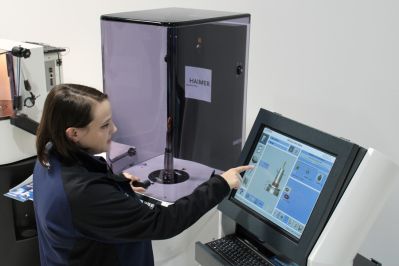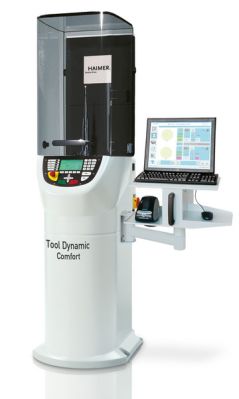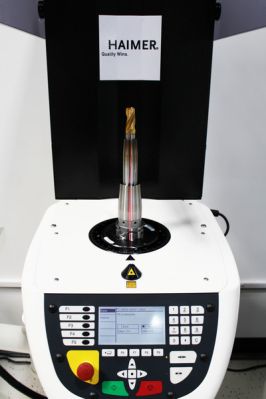Shops Can Machine Parts Faster -- If They Find the Right Balance
It is common for machinists to run into issues in their production. From poor surface finish or tool life to an increase in vibration or creating oval holes instead of round holes during boring head applications, machinists try to solve these issues through many different avenues. However, they often don't realize that their problems may be due to...balance.
Usually, machinists solely rely on having the tool holder pre-balanced. However, the tool holder is not the only thing inserted into the machine. Operators have to complete their tool assembly by adding the collet, nut, cutting tool, pull-stud and more before placing it in the spindle. All the different components could be unbalanced and can influence the overall balance of the full tool assembly.

Megan Orlando, Technical Customer Service Representative at Haimer USA, demonstrates one of HAIMER's balancing machines.
"You really need to have an in-house balancing machine in order to check the condition of the tooling assembly," explains Brendt Holden, President of Haimer USA. "Even if you order special form tools to come to you balanced -- how do you know if it really arrives to your facility balanced?"
It is important to have an idea of the balance condition of the full assembly for each application, regardless of how fast the machine is running in RPM. Of course, balancing is important for high RPM applications in order to protect the machine spindle and the reduce vibrations, but it is also needed during low RPM applications.
"In many cases, some of the most dramatic advantages of balancing tooling assemblies can be found at low RPM applications like boring heads or face-mill arbor assemblies," Brendt explains. "Our advice is to always look at applications that present challenges that no one can figure out how to solve. Maybe they looked at the fixturing, or the machine condition, or the cutting tools, but still they are not getting the performance they wanted. Did they look at balancing? If not, this would be the time to investigate balancing."
So how do HAIMER balancing machines work? Once a machinist assembles his or her full tool assembly, he or she brings it to the balancing machine and runs the first cycle by placing it in the balancing machine's spindle. Then, the machinist must index the tool assembly 180° in order to isolate the unbalance in the tooling assembly.

HAIMER Tool Dynamic TD Comfort
Once the unbalance is measured, the machinist can either balance the assembly by drilling (remove metal manually), set screws (add weight to tool holder) or two balancing rings which displace the weight evenly. After this, the machinist runs the cycles again and confirms that the tool holder assembly is now in balance, typically G2.5 at 25,000 rpm.
The most popular machine Haimer USA sells is the Tool Dynamic TD Comfort because of its ease of use and most importantly, its accuracy.
"We utilize a spindle that clamps the tooling assembly as if held in the machine tool spindle," explains Holden."
The machine itself has a hard bearing spindle that utilizes centrifugal force sensors to measure the unbalance of the tooling assembly. The machine is equipped with a PC, keyboard, mouse and monitor. The big screen enables operators to input tool data quickly all through the comfort of a graphical user interface. In addition, the software of the machine offers the possibility to correct the unbalance with the help of a milling program, which is very common to correct extreme unbalance.
"The ease of use comes from the software that guides the user through an easy modification process," Brendt adds.
Once a machine shop implements balancing, the results are immediate and dramatic.

HAIMER Tool Dynamic TD Comfort Plus
"We have some customers tell us that once they started to balance their face mills, they were able to cut their face mill insert yearly consumption in half," states Holden. "We have customers that are able to get the full capability out of their machine tools once they start to balance the tooling assemblies -- in other words, they can machine their parts faster."
One particular customer, Precision Tool in Brainerd, Minn., noticed a big difference in their production after implementing HAIMER's Tool Dynamic TD 2009 balancing machine while manufacturing an aspirator attachment for a seeding machine. When the part spins in the machine, it gets up to 12,000 rpm. If it is out of balance, it shakes the entire seeding machine -- making all the components vibrate and causing premature retirement of the machine due to excess wear.
No one could make the part work to spec, but Precision Tool could. While their attachment carried a premium price compared to other vendors, the customer saw the value that the superior part would bring to the overall quality of their seeding machine. This was all due to Precision Tool's ability to utilize the balancing machine on not just tool holder assemblies, but on physical parts as well. The TD 2009 machine was able to identify unbalance and accurately designate the exact position where weight correction was needed.
Regardless of what issues machinists are facing (increased vibration, poor tool life, etc.), it is important to recognize that unbalance could be the hidden problem that affects many different aspects in the production.
Want more information? Click below.
Rate this article
View our terms of use and privacy policy